Mitsubishi 4G63:
The 4G63 was a 1997 cc version. SOHC and DOHC were produced. The DOHC version was introduced in 1987 in the Japanese market Galant VR-4 and came turbocharged or naturally aspirated. It is found in various models including the 1988-92 Galant VR-4 and the U.S. market 1990-1999 Eclipse.
The SOHC version was used in Mitsubishi Galant models until 1997 across the world. It has 101 KW of output and 176 NM of torque at 4750 rpm.
The Mitsubishi Eclipse, Eagle Talon and Plymouth Laser introduced the DOHC turbocharged intercooled version to the U.S. in 1989 through Diamond Star Motors, a joint venture between Mitsubishi Motors and the Chrysler Corporation (now DaimlerChrysler). 1990 to late April 1992 came with beefier rods and used 6 bolts to secure the flywheel to the crankshaft, May 1992 to present EVO versions have lighter rods and use 7 bolts to secure the flywheel to the crankshaft. They are referred to as the "six bolt" and "seven bolt" engines, respectively.
Output for the US-spec 2003 Mitsubishi Lancer Evolution is 271 hp (202 kW) at 6500 rpm with 273 ft·lbf (370 N·m) of torque at 3500 rpm. It has a cast iron engine block and aluminum DOHC cylinder head. It uses MPI multi-point fuel injection, has 4 valves per cylinder, is turbocharged and intercooled and features forged steel connecting rods. With the release of the Lancer Evolution IX (286hp @ 6500rpm, 289ft*lb of @ 3500rpm, 7000rpm redline), it has received Mitsubishi's MIVEC variable valve timing system, which gives smoother power delivery and a flatter torque curve.
In the United Kingdom, a special Lancer Evolution, the FQ-400, produces 302.13 kW (405.2 hp), from a 4G63 engine. At 202.6 hp (151.3 kW) per liter, it has possibly the highest specific output per liter of any production engine.
Its turbocharged variant, 4G63T (also sometimes referred to simply as the 4G63), has powered Mitsubishi vehicles in World Rally Championships for years in the Mitsubishi Galant VR-4, Lancer Evolution, Carisma GT and Lancer WRC04. It was the powerplant of the Lancer Evolution when Tommi Mäkinen won his four sequential WRC championships.
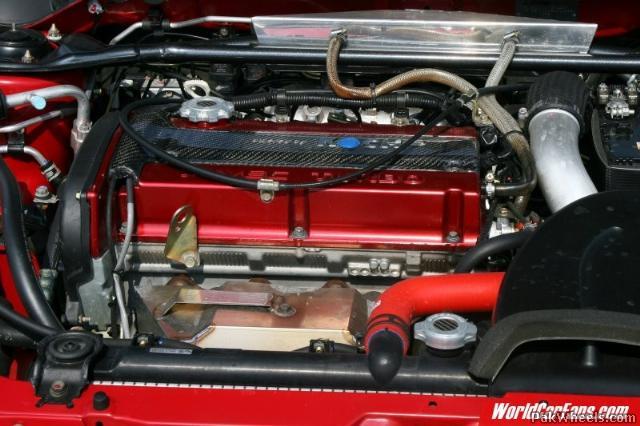

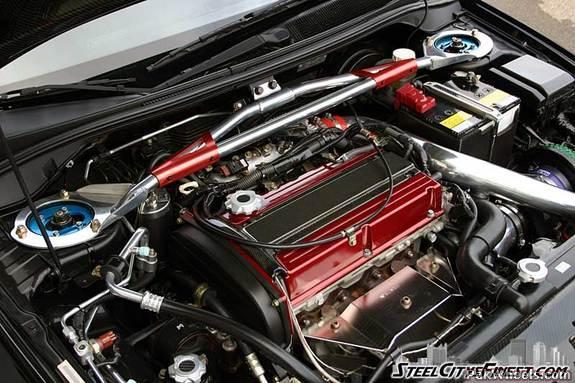
Honda K20A:
Found in:
* 2007- Honda Civic Type-R (FD2)
o Displacement: 1998 cc
o Compression: 11.7:1
o Power: 222 bhp (225 PS, 165 kW) @ 8000 rpm
o Torque: 159 ft·lbf (215 N·m) @ 6100 rpm
o Redline: 8400 rpm
The Honda K series engine is a four-cylinder otto cycle engine. It is available in 2.0 L and 2.4 L naturally-aspirated variants, and a 2.3 L turbocharged model.
The K series engines are equipped with DOHC valvetrains and use roller rockers to reduce friction. The engines use a coil on plug, distributorless ignition system with a coil for each spark plug. This system eliminates the need for spark plug wires as well as the problems associated with them. It also allows the ECU to precisely control the ignition timing based on various sensor inputs. The cylinders have cast iron sleeves similar to the B-series engines, as opposed to the FRM cylinders found in the H-series.
Two versions of Honda's i-VTEC system can be found on K series engines, variable timing control (VTC) can be found on the intake cam of both versions.
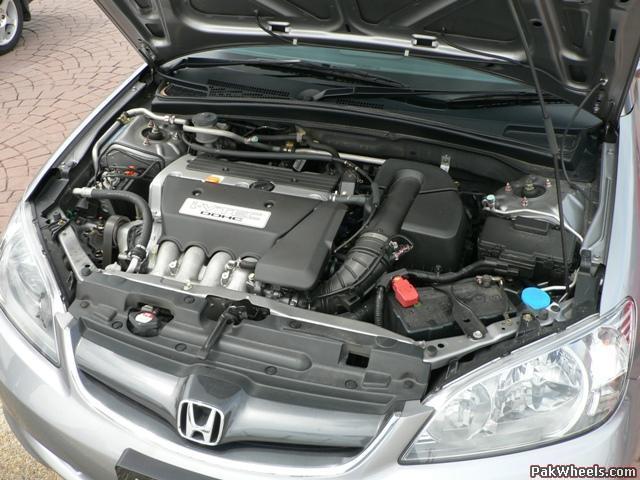
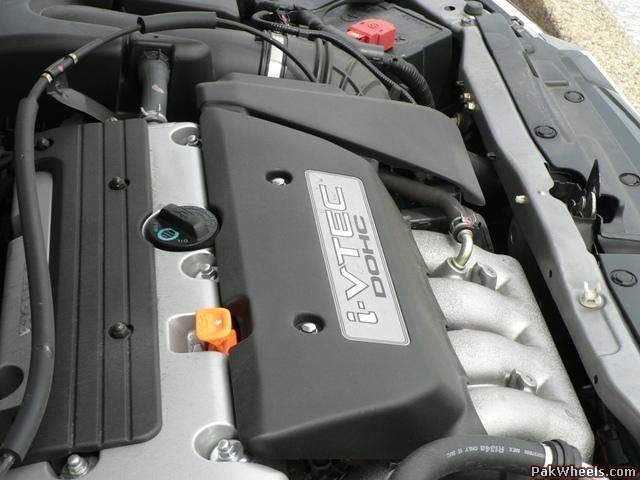
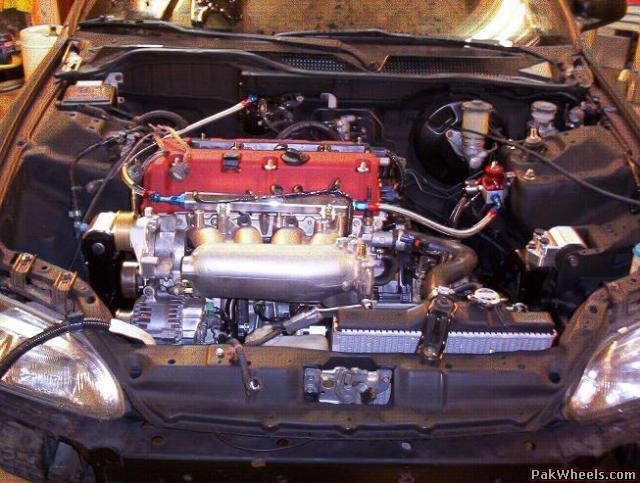
Honda B series:
he B-series Honda DOHC engines are popular automotive engines from the modern series of Honda engines. They are good performers from the factory having models with around 126hp to ddaround 200hp and even some models having a redline over 8,900 rpm. They accept high performance modifications well without much risk to reliability. The engine has been made in 1.6, 1.7, 1.8, and 2.0 liter variants, with and without VTEC (variable valve timing and electronic lift control). Later models have some minor upgrades, for instance modifications to the intake valves and ports and piston tops, and moving the dipstick away from the exhaust manifold.
Engine swaps
The B-series engine is one of the most common engines used for engine swaps in Hondas. The B-series engines are commonly chosen due to their reliability, and their ability to produce high horsepower in comparison to their displacement (over 100 hp/L). Various versions are found in American junkyards, mostly in the Acura Integra. Honda B-series engines are also found in many JDM Honda vehicles and are quite plentiful in Japanese junkyards, and great numbers have been imported from Japan in the last few years.
The JDM engine contains some slightly different parts (e.g. throttle body) than the USDM version, and tends to have slightly higher horsepower ratings with the JDM equivalent of the B18C1 producing 10 horsepower (7 kW) more than its USDM counterpart. Also, the wiring harness is set up for right hand drive as Japan uses, rather than left hand drive as in the United States or Canada; this is just a minor nuisance for left hand drive countries, however, as the wires will fit only if some mounting clips are released.
The B-series engine fits nicely under the hood of many Civics, a common target for such swaps. Note that the actual B-series engine will not adapt to the transaxles other engine models, therefore the entire powertrain, i.e. engine and transaxle, must be swapped as a unit; normally, however, the entire powertrain is what is meant when "engine" swaps or availability of used "engines" is discussed with respect to front wheel drive cars.
Note that the ECU (engine computer) must be swapped as well. Aftermarket modified ECUs are available, ranging from close to stock B-series to wildly modified, with various degrees of skill. If a VTEC engine is to be installed in a car which did not have a VTEC engine, then additional wiring for the VTEC will have to be run; a minor chore (**With the exception of the Civics produced for the 1992 year. All came equipped with the VTEC wiring despite most models lacking VTEC).
The B-Series engine swap is very popular for 1992 through 1995 Civic owners since it is so easy to perform. The B-series engine was available in the United States 1994 Civic-based Del Sol; therefore the stock Honda motor mounts, axles, transmission linkage, and other auxiliary parts on the B-series engine (as well as the ECU, of course) will adapt it to any Civic of that era. Some swaps such as the B20B from the CRV are hard to perform due to the CRV's transmission not fitting therefore the need of a piecing together a transmission. The corresponding parts that came with the stock SOHC D-series engines will not fit the B-series, however. Unfortunately, most of the available engines are removed from the car without any of these parts, and often even the wiring harness has been destroyed, so the parts have to obtained by either scouring junkyards or purchased from Honda at substantial expense. If at all possible, an engine with a complete set of these parts is greatly to be desired over just the engine itself for this kind of swap.
If the engine is complete with these parts, very little else is needed for the 1992-1995 Civic, whether two door, four door, or hatchback. A bracket to adapt the existing throttle cable to the B-series engine is available from aftermarket manufacturers. As mentioned above, it may be necessary to add the VTEC wiring. If the B-series engine is older it may have a mechanical cable-operated clutch, and an aftermarket bracket will be needed to adapt it to the hydraulic clutch cylinder on the car. The only part which may need to be purchased from Honda is the bracket for the air conditioning compressor, if air conditioning is to be used; the stock bracket with most B-series motors will not fit, only the very specific bracket used for the B16 fitted in the Del Sol. For other generations, the swap is slightly harder because custom engine mounts must be used. Due to the popularity of the swaps, however, there are several manufacturers who make suitable mounts, such as Hasport.
B16
B16A
Note: All j.d.m. B16A engines are stamped 'B16A' (with no number after the "A" to identify version).
* VTEC
* Found in:
o 1989-1993 JDM Honda Integra RSi/XSi (DA6/DA8)
o 1989-1991 JDM Honda CRX SiR (EF8)
o 1989-1991 JDM Honda Civic SiR/SiRII (EF9)
+ Displacement: 1595 cm³
+ Compression: 10.2:1
+ Rod/stroke ratio: 1.74
+ Power: 158 hp @ 7600 rpm & 112 ft·lbf @ 7000 rpm
+ Transmission: S1/J1/Y1/A1/YS1
o 1992-1995 JDM Honda Civic SiR/SiRII (EG6/EG9)
+ Displacement: 1595 cm³
+ Compression: 10.4:1
+ Power: 168 hp @ 8800 rpm & 116 ft·lbf @ 7300 rpm
+ Transmission: S4C
o 1992-1995 EDM Honda Civic VTi
+ Displacement: 1595 cm³
+ Compression: 10.4:1
+ Power: 158 hp @ 7600 rpm & 116 ft·lbf @ 7300 rpm
o 1992-1996 JDM Honda CR-X del Sol SiR
+ Displacement: 1595 cm³
+ Compression: 10.4:1
+ Power: 158 hp - 170 hp & 111 ft·lbf - 116 ft·lbf
B16A1
* VTEC
* Found in:
o 1989-1991 EUDM Honda CRX 1.6i/VTi (EE8/ED)
o 1990-1991 EUDM Honda Civic 1.6iVT (EE9)
+ Displacement: 1595 cm³
+ Compression: 10.2:1
+ Power: 158 hp @ 7600 rpm & 111 ft·lbf (151 N·m) @ 7000 rpm
B16B
* VTEC
* Found in:
o 1997-2000 Civic Type-R[EK9]
+ Displacement: 1595 cm³
+ Compression: 10.8:1
+ Bore: 81mm
+ Stroke: 77mm
+ Power: 185 hp (137 kW) @ 8200 rpm & 118 ft·lbf (160 N·m) @ 7500 rpm
+ Transmission: S4C With LSD
B18C5
* VTEC
* Found in: USDM DC2 Integra Type-R (Integra Type-R)
o 1997-2001 Integra Type-R (**Note: This model was not produced for the 1999 production year)
* Displacement: 1797 cm³
* Compression: 11.0:1
* Bore: 81 mm (3.189")
* Stroke: 87.2 mm (3.433")
* Rod Length: 137.9 mm (5.429")
* Rod/Stroke Ratio: 1.58
* Power: 200 hp @ 8000 rpm & 130 ft·lbf (176 N·m) @ 7500 rpm
* Transmission: S80 w/LSD
So guyz wat do u think ???
Which one is better ??
Which one can deliever better performance when equipped with turbocharger n other stuff ??
Which one is better option for engine swap in civics ??



